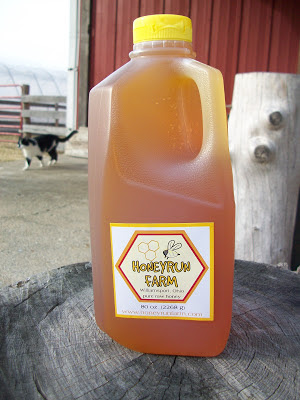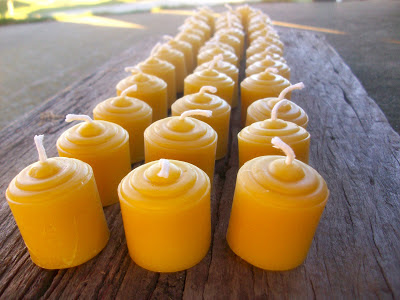-posted by Jayne
My daughter asked me this last week while we were eating a pretty typical lunch... peanut butter and jelly sandwiches, some carrots, and milk.
"You want a bowl of bee pollen for lunch?" I asked, kind of chuckling to myself about her nonchalance in asking this question.
"Mmm-hmm." She responded.
"Okay..." I said, as I filled a bowl with about 3 Tablespoons of pollen and handed it to her.
I went back to cleaning the counter and doing dishes, when Mason said, "Mom, I did not get a bowl of bee pollen for lunch."
"You want a bowl of pollen, too?" I asked.
"Yes."
"Okay, one more bowl of bee pollen, coming right up."
I love it that our kids find this as completely normal. I'm pretty sure there aren't many other 3 and 4 year olds eating bowls of pollen along with their sandwiches for lunch. Somebody please tell me when this will backfire and they start calling us weird hippie beekeeper parents?
I have a lot of great blog post ideas running through my head, but for lack of time, I will give you one quick and easy craft project we tried this week. Wax Dipped Leaves! Did you know that dipping leaves in beeswax preserves their color, and creates beautiful garlands for your Thanksgiving decorations? Of course they won't last forever, but they will last long enough for you to enjoy the colors of fall a bit longer.
You will need:
About 1 lb. beeswax
A variety of colorful leaves
A double boiler, with a container you plan to use only for melting
beeswax
Wax or Candy Thermometer
A string and some thread, if you'd like to string your
leaves.
Newspaper or an old sheet to cover your work area
Directions:
1. Melt your beeswax using a
double boiler- a small saucepan containing the beeswax, sitting inside a larger
pan of water. Melting beeswax over direct heat is very dangerous, as hot
beeswax is flammable and can ignite. Use a thermometer to monitor the
temperature of your wax. Stainless steel is recommended since copper, brass,
and iron can change the color of the wax, making it look dull.
2. When the beeswax
has reached 150-160 degrees and has completely melted, you are ready to begin
dipping. Quickly and steadily dip
your leaves down and up out of the beeswax. DO NOT hold the leaf in for a long period of time, or the
wax will coat the leaf completely and you won't be able to see the color of the leaves through the yellow wax.
3. Allow the
leaf to drip over the container for a few seconds before laying it aside to dry completely.
4. When you
have finished dipping all the leaves, string them together with a needle and thread
and hang in a beautiful location.
That's it!
 |
Make sure your kids wear old clothing and understand
the dangers of working with hot wax! |
Another fun project I attempted was making floating beeswax candles out of acorn caps. This worked really well, except the oak tree right outside our honey house has acorns with curly, ruffled edges, that just happen to be flammable. Good thing they were floating in a bowl of water, right? I am still looking for some large acorn caps that will not pose a fire hazard. I used tea light wicks for these candles. I do not plan to sell these, but if you wanted to buy some, I have seen them for sale in other shops on Etsy. What a fun centerpiece for Thanksgiving!
 |
| Floating beeswax candles in acorn caps |
I have a ton of other beeswax craft projects running through my mind right now. As the weather gets colder I long for opportunities to engage my crafty side. Can you believe it is November already??
Go out and collect some leaves for this project before they all blow away!














































